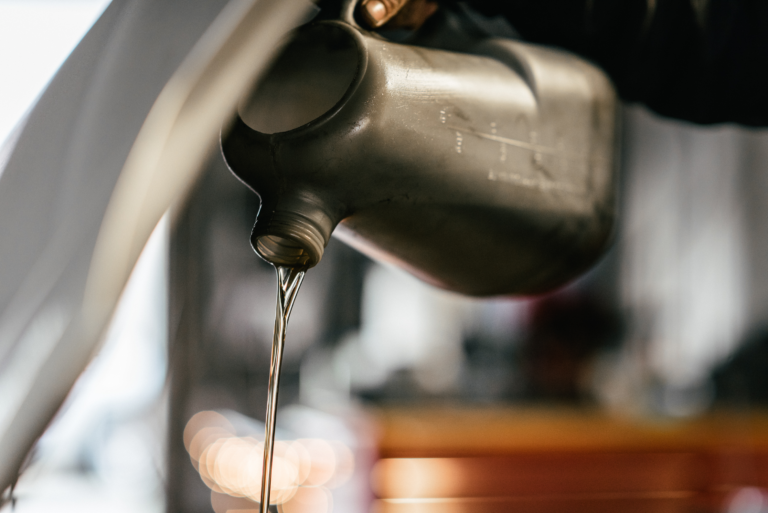Blog
What Fluid Is Leaking From Your Car? A Color-Coded Guide
You leave your car for a few minutes — or a few hours, or a few days — and come back to find a puddle forming underneath it. that’s probably not good. maybe it’s just water condensation dripping down, but odds are it’s a sign of a fluid leak.

your car is a complex piece of equipment. it uses a variety of fluids for different functions, including:
- engine oil, for lubricating the engine
- coolant, for keeping the engine at the right temperature
- transmission fluid, for lubricating and operating the transmission
- brake fluid, for operating the brakes
- washer fluid, for cleaning the windshield
- power steering fluid, which makes it easier to steer
any of these fluids can leak from your vehicle, leaving a distinctive residue on the ground.
these fluids can be identified by color and texture, and sometimes odor. most will need immediate attention from a mechanic to avoid a situation that could leave you stranded by the side of the road with a big repair bill. with that in mind, let’s take a closer look at the fluids that keep our cars, trucks and suvs running properly, and how to identify them.
how to check your car for a fluid leak
if you see a puddle under your car on your garage floor, driveway or parking spot, this is very likely a sign of a leak. a good way to determine the amount and location of the fluid leakage is to place a large piece of cardboard under your car when you park it overnight. check the cardboard the next morning to see how much has leaked out, what color it is, and where it is coming from. this is useful information to have and share with your mechanic in order to identify which fluid is leaking, as well as where it’s coming from.
get it diagnosed by a professional

if your leak is red
your vehicle uses two fluids that are red: power steering fluid and automatic transmission fluid. they are both hydraulic fluids. some vehicles actually use automatic transmission fluid in their power steering systems. check your owner’s manual.
power steering fluid: this can be red, reddish-brown, or brown if it is old. it’s thin in consistency, with an oily feel. it can smell like burnt marshmallows. your mechanic can inspect your power steering system.
automatic transmission fluid: this also starts out red when new, then progressively turns reddish-brown as it wears and the miles pile up. it feels oily and slick, and thinner than your engine oil. it will smell like petroleum. if you find this, a transmission inspection is in order, especially if you notice other signs of a transmission problem, like delayed shifting when the engine is cold.
if your leak is orange
leaks that are orange in color can originate in two different areas of your vehicle:
coolant: this can be an indicator that there is rust in your cooling system, and the rust particles have mixed in with the coolant. coolant feels slimy and has a sweet odor. the top cause of serious engine damage is loss of coolant. if your car consistently loses fluid, contact your repair facility immediately. have your cooling system inspected.
automatic transmission fluid: this can also turn an orange-ish color as it ages. a mechanic can inspect your transmission to confirm.
if your leak is green, yellow or pink
coolant: this comes in many fluorescent colors, and can leak from many places throughout your cooling system. coolant has a sweet odor and a slimy texture. losing coolant will lead to overheating if not addressed, and if the engine overheats, you can be left stranded and with a huge repair bill. an inspection of your cooling system can identify the source of the leak.
if your leak is blue
windshield washer fluid: this is thin and watery, and smells like window cleaner. it can come in other colors, including green. check to see if your washer fluid reservoir is cracked, or have a technician look at its seals and lines.
if your leak is light yellow
brake fluid: this hydraulic fluid starts out as light yellow, then gets progressively darker over time and can end up dark brown if it’s not maintained. brake fluid will feel oily to the touch, is very slippery, and may smell like fish oil.
important: if you find this, it isn’t safe to drive your car. instead, get it to a mechanic, where the brake system can be inspected. brake lines or other parts may need repair or replacement.
» more: why do my brakes feel spongy?
if your leak is brown
engine oil: this starts out as a light brown shade when new, then turns darker brown over time, eventually becoming nearly black after picking up dirt and byproducts of combustion as it circulates through the engine over thousands of miles. engine oil has a distinctive smell (check your engine dipstick to get a whiff and compare), and feels thick and slippery to the touch. you can keep your oil level topped off if the leak is minor, but it’s important to get even a small oil leak inspected and fixed sooner rather than later.
if your leak is clear
water: this fluid looks and feels like … water! it’s likely the result of condensation draining from your air conditioner, and is no cause for alarm.
gasoline: you can best detect gasoline by its distinctive odor, not its texture.
important: if you detect a gasoline leak, it’s unsafe to drive your vehicle. call your mechanic for advice on how to proceed.
general fluid leak tips
- a puddle that is 3 inches or wider under your car is considered a serious leak and requires immediate attention.
- a puddle between 1 and 2 inches wide is referred to as “seepage” or a “drip.”unless it’s brake fluid or gasoline, the condition isn’t as serious.
- the morning after your vehicle is serviced, check underneath the car for fresh fluid. if there’s still a leak, immediately call the repair facility.

